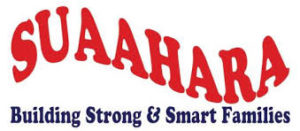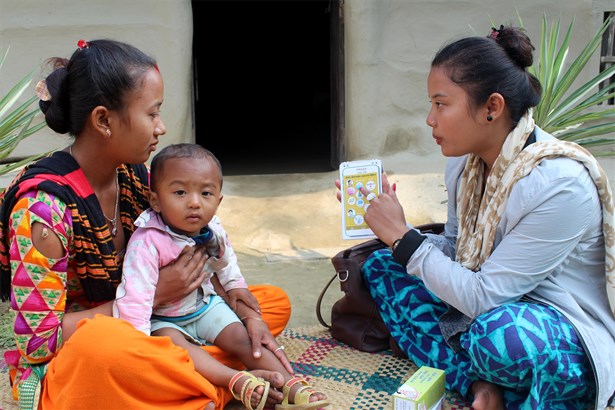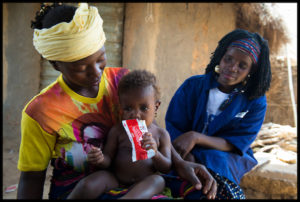Integration of Maternal Nutrition into Nepal’s Health Service Platforms: What’s Happening?
This article was first published in Nutrition Exchange South Asia: Maternal Nutrition and can be found here. Nutrition Exchange is a free publication that includes non-technical articles on nutrition policy and programming written by and for national and sub-national stakeholders working in nutrition and related sectors. Thanks to ENN and UNICEF ROSA for providing permission to share with our audience.
Interested in hearing more about Suaahara II? Listen to our webinar recording where members of the project team shared their experiences and answered your questions on the ‘how to’ aspects of implementation.
Introduction
Although maternal undernutrition in Nepal has greatly reduced over the last two decade (1), the 2016 Nepal Demographic and Health Survey (NDHS) revealed that the proportion of women of reproductive age (WRA) who are too thin has remained at around 17% and 12% of children are born with low birth weight, while the proportion of WRA who are overweight or obese has increased from 9% in 2006 to 22% in 2016 (2). The Government of Nepal (GoN) was one of the first countries to join the global Scaling Up Nutrition (SUN) Movement, creating an enabling environment for scaling up nutrition in the country. Several policies, including the Nepal Health Sector Strategy (2015-2020) and the Multi Sector Nutrition Plan (MSNP) (2012- 2022), recommend specific steps to reduce the maternal malnutrition burden, including delivery of multi-sector interventions. This article highlights early learning and experiences from the implementation of a large-scale, multi-sector programme that addresses maternal nutrition in Nepal and supports integration of maternal nutrition interventions in GoN’s health and nutrition systems.
Multi-sector programming at scale
 Various initiatives and stakeholders, including donors and non-governmental organisations, support the GoN’s efforts to reduce undernutrition. One such initiative, a USAID-funded multi-sector programme called Suaahara II (meaning ‘good nutrition’), has invested USD63 million for a five-year period (2016-2021) to support rollout of nutrition-specific and nutrition-sensitive strategies in 42 of 77 districts (3,353 of 6,741 wards) (3). The programme focuses on improving health and nutrition, particularly among households, during the 1,000-day period between a child’s conception and second birthday. Suaahara II’s primary focus areas are: 1) improving household nutrition, health and water, sanitation and hygiene (WASH) behaviours; 2) improving the use of high-quality nutrition, health and family planning services; 3) promoting production and consumption of diverse and nutritious foods; and 4) strengthening nutrition-related governance structures and policies. Household and community-level social and behaviour change (SBC) efforts engage all household members, not only women, with the aim of improving knowledge and practices related to nutrition and, in turn, increasing demand for health and nutrition services. Suaahara II also works at local and national levels to build government frontline-worker capacity, strengthen government systems and support nutrition policies and programmes at all levels of government. Using a continuum-of-care model, specific interventions are designed for particular stages of the 1,000-day period: pregnancy, birth and post-natal care, early childhood, and adolescence.
Various initiatives and stakeholders, including donors and non-governmental organisations, support the GoN’s efforts to reduce undernutrition. One such initiative, a USAID-funded multi-sector programme called Suaahara II (meaning ‘good nutrition’), has invested USD63 million for a five-year period (2016-2021) to support rollout of nutrition-specific and nutrition-sensitive strategies in 42 of 77 districts (3,353 of 6,741 wards) (3). The programme focuses on improving health and nutrition, particularly among households, during the 1,000-day period between a child’s conception and second birthday. Suaahara II’s primary focus areas are: 1) improving household nutrition, health and water, sanitation and hygiene (WASH) behaviours; 2) improving the use of high-quality nutrition, health and family planning services; 3) promoting production and consumption of diverse and nutritious foods; and 4) strengthening nutrition-related governance structures and policies. Household and community-level social and behaviour change (SBC) efforts engage all household members, not only women, with the aim of improving knowledge and practices related to nutrition and, in turn, increasing demand for health and nutrition services. Suaahara II also works at local and national levels to build government frontline-worker capacity, strengthen government systems and support nutrition policies and programmes at all levels of government. Using a continuum-of-care model, specific interventions are designed for particular stages of the 1,000-day period: pregnancy, birth and post-natal care, early childhood, and adolescence.
Integration of maternal nutrition interventions in the health system
To facilitate integration of maternal nutrition interventions in antenatal care (ANC) platforms, Suaahara II worked with the GoN to update the Maternal, Infant, and Young Child Nutrition (MIYCN) training package based on global evidence (for example, inclusion of adolescent nutrition), and to integrate nutrition assessment and counselling services into the MIYCN manual for all health workers. Using adult-learning principles, the training focus was more about building skills for nutrition counselling rather than just knowledge transfer, particularly during ANC visits. New protocols and job aids were also developed and rolled out to ensure health workers have up-to-date materials for conducting quality nutrition assessment, counselling and support for pregnant women. Following the GoN’s cascade approach to training, the focus was placed on enhancing the competencies of female community health volunteers (FCHVs) on the importance of referral of maternal malnutrition cases to facilities, distribution of iron and folic acid (IFA) tablets, and counselling mothers on the importance of dietary quality and rest during pregnancy. Suaahara II field staff continue to support healthcare providers in facilities and FCHVs with post-training follow-up and on-site coaching. Suaahara II’s SBC efforts support GoN health system efforts to improve service utilisation and quality of care. For example, targeted text messages encourage households to attend ANC. Furthermore, to enhance the engagement of men in maternal care, Suaahara II designed a motivational ‘Letter to the father’ from the unborn baby, which is given to the household during ANC and explains what role the father can play during pregnancy and in raising a healthy and well-nourished young child.
Social and behaviour change strategies
The primary SBC approaches involve: interpersonal communication, community events, mass media and an SMS messaging campaign. Interpersonal communication primarily involves Suaahara II frontline workers making home visits to counsel households on nutrition, health and WASH. Community events include food demonstrations and key life events celebrating the start of pregnancy, delivery and a child turning six months of age. Suaahara II mass media output is primarily a weekly radio drama, Bhanchhin Aama (‘Mother knows best’), that features storylines on health and maternal nutrition, and accompanying call-in weekly audience response programme, as well as social media output, including YouTube and Facebook, to share Bhanchhin Aama. A text message campaign is the newest addition to these outreach efforts. For all these household and community activities, Suaahara II field staff collaborate with the GoN’s cadre of FCHVs, based in each local community, to motivate families to adopt healthier practices. This collaboration happens naturally, given that both cadre are located in the same communities, and that Suaahara II uses existing government platforms such as the FCHV monthly meetings at the health facility, monthly Health Mothers’ Group meetings, and vitamin A distribution campaigns. Suaahara II field staff and FCHVs often conduct joint home visits for counselling and co-lead community events, including food demonstrations and key life events.
Linkages across sectors and levels of government
Beyond specific sectors and programmes, Suaahara II staff coordinate on a continual basis with government line ministries and divisions across all relevant sectors: health, agriculture, livestock, education, and WASH, as well as multi-sector platforms and networks in order to reinforce linkages. This includes collaboration with newly elected political leaders on nutrition issues, participating in regular, provincial-level multi-sector meetings, and supporting the Nutrition Technical Committee at the federal level and Nutrition and Food Security Steering Committees at municipal and ward levels. Efforts are paying off in terms of building shared ownership among diverse stakeholders and spurring local investments in nutrition. The GoN has increasingly assumed responsibility for institutionalising and funding some Suaahara II initiatives, such as key life event celebrations, food demonstrations, letter to the father, egg distribution for newly pregnant women, and the SelfApplied Technique for Quality Health (SATH) approach for increasing demand for health and nutrition services. This government-led adoption and scaleup of better practices and innovations from Suaahara II increases programme reach and sustainability. As a result of Suaahara II and other nutrition stakeholders’ intensive advocacy efforts with newly elected local leaders in intervention areas between June 2017 and July 2018, local leaders committed USD3.5 million (nearly 400 million Nepalese rupees) for nutrition-specific activities in Suaahara II programme districts.
Early indications of improvement
Using Suaahara II’s 2017 and 2018 annual monitoring surveys (using a cross-sectional, multi-stage random sampling with a sample of 3,500+ households with a child aged 0-5 years, collected by an external survey firm), positive trends in service utilisation outcomes were found. (It should be noted that figures must be treated with caution in the absence of control groups, and that attribution needs to be confirmed through a more rigorous evaluation.) Births receiving at least four ANC visits increased from 73% to 77%; pregnant women being weighed during ANC increased from 87% to 93%; women consuming all 180 IFA tablets during pregnancy increased from 52% to 59%; and women consuming a minimally diverse diet (5+ of 10 food groups) increased from 36% to 42% (4); however, numbers of married women who reported using a modern method of family planning (about one in three) remained unchanged.
Challenges and lessons learned
Challenges for Suaahara II and similar programmes are numerous. A programme covering more than half the communities in a country, some quite remote, requires significant investment in personnel and resources for programme operations, in addition to skilled technical staff. Assuring quality of implementation is a challenge, given the breadth of interventions, sequencing of programme activities and context. Overcoming long-standing gender and socio-cultural norms in order to create optimal nutrition, health and WASH practices requires significant investments of time and trust-building. Setbacks like frequent health worker turnover, however, constrain long-term progress. Utilising multiple communication channels and reaching multiple household members likely increases the chances of desired behaviour changes. Focusing on a limited number of priority behaviours is important, since both households and frontline workers can be overwhelmed if the programme focuses on numerous behaviours at once. Moreover, explicit targeting of disadvantaged households was found to help narrow the equity gaps within the same communities (5).
What next?
Scaling up best practices for multi-sector nutrition approaches implemented through facility and community workers will require building sustained technical and management capacity at all levels. Quality assurance of these activities requires regular on-site coaching and mentoring. Given the continued low proportion of pregnant women who consume the recommended dose of IFA and poor dietary diversity in Nepal, who are also particularly lacking in consumption of animal-source foods, Suaahara II will continue to prioritise maternal nutrition and work with the GoN to mainstream integration efforts further and improve coverage. This could include a comprehensive nutrition training package for mid-level managers and health workers, ensuring that adolescent nutrition is mainstreamed in a life-cycle approach so that adolescents are not lost in the gap between child and adult services, along with rigorous research to generate evidence of best practices and effective interventions.
Citations
- Cunningham K, Headey D, Singh K, Karmacharya C, Pandey Rana P, et al 2017. Maternal and Child Nutrition in Nepal: Examining drivers of progress from the mid-1990s to 2010s. Global Food Security 13 (2017) 30–37, www.elsevier.com/locate/gfs
- Government of Nepal, Ministry of Health and Population, 2016. Nepal Demographic and Health Survey 2016.
- With the recent shift to a federal system in Nepal, there has been a structural transition from district, village development committee and ward levels to province, rural and urban municipality, and ward levels.
- Suaahara II Good Nutrition Programme 2018. Annual Survey Year 2, 2018.
- Cunningham K, Singh A, Pandey Rana P, Brye L, Gautam B, Lapping K, Alayon S, Underwood C, Klemm Rolf DW et al 2016. Suaahara in Nepal: An at‐scale, multi‐sectoral nutrition program influences knowledge and practices while enhancing equity, DOI 10.1111/mcn.12415
Authors
Bhim Kumari Pun is the Senior Integrated Nutrition Programme Manager in the Suaahara II programme.
Khim Khadka is Provincial Health Director, Gandaki Province, Nepal. Basant Thapa is the Family Planning Advisor in the Suaahara II programme.
Krishna Prasad Lamsal is the Community Nutrition Specialist in the Suaahara II programme. Pooja Pandey Rana is Deputy Chief of Party in the Suaahara II programme.
Dr Kenda Cunningham is the Senior Technical Advisor for Integrated Nutrition and Monitoring, Evaluation and Research for Learning in the Suaahara II programme.
All authors deeply acknowledge the United States Agency for International Development (USAID) (Grant/Award Number: 367‐A‐11‐00004) for its financial support. The contents of this article are the sole responsibility of the authors and do not necessarily reflect the views of USAID or the United States Government.
Interested in hearing more about Suaahara II? Join our upcoming webinar where members of the project team will be answering your questions. More details here.
Have an idea or a comment on any of the issues discussed above? We welcome your feedback – you can comment on this post on our LinkedIn feed or write to us at info@implementnutrition.org.



